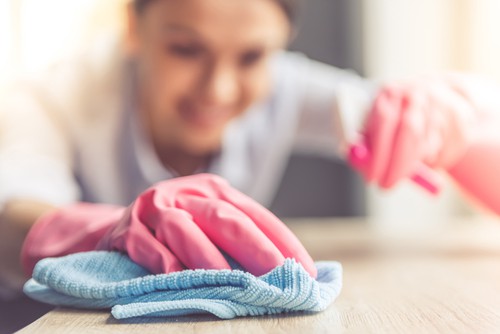Safest Ways of Cleaning, Sanitizing & Disinfecting. Disinfection is a combination of chemical, physical and mechanical methods for the destruction of vegetative and spore forms of certain groups of microorganisms that are the sources of anthrax, cholera, brucellosis, coronavirus, etc. The purpose of cleaning, sanitizing, and disinfecting is the prevention of the spread of infectious diseases for the formation and maintenance of safe living conditions for objects, by destroying (disinfecting) pathogenic and conditionally pathogenic microorganisms (except for spore forms) from objects, external environments, medical equipment, instruments or skin integuments.
Safest Ways of Cleaning, Sanitizing & Disinfecting- Disinfection levels

- High – aimed at the destruction of all microorganisms with the exception of spore forms of bacteria.
- Medium – Mycobacterium tuberculosis, vegetative forms of bacteria, viruses, fungi are destroyed.
- Low – most bacteria are destroyed, certain types of viruses, fungi.
Safest Ways of Cleaning, Sanitizing & Disinfecting –
There are four basic disinfection methods

Mechanical disinfection
Mechanical (shaking, vacuuming, ventilation, washing and filtering). With the mechanical method, the death of microorganisms does not occur, but only their removal. The most widely used automated method to reduce microbes in the air is operating rooms, dressings and other rooms of medical institutions. For this purpose, recirculation plants (VOPR) are used.
Physical disinfection
Physical disinfection (based on the death of microorganisms under the influence of physical disinfecting agents). Influenced by high (boiling, the action of hot dry and moist air), burning, burning (flaming), calcination) and low (freezing) temperatures; radiant energy (ultraviolet radiation, γ – radiation, β – emission).
Chemical disinfection
Chemical (by the method of exposure to disinfectants by irrigation, rubbing, dipping or soaking, falling asleep with a dry preparation) Biological (based on the antagonistic action between microorganisms, wastewater disinfection in the filtration fields, etc.)
Biological disinfection
Biological (based on the antagonistic action between microorganisms, wastewater disinfection in the filtration fields, etc.).
Various factors affect the effectiveness of disinfection, and each of them can reduce the activity of the disinfection process and even reduce it to zero.
Disinfectants vary in purpose and form of release. The types of main active ingredients in the chemical form of disinfection include alcohols (ethyl, isopropyl, and others), halogens (the most common – chlorine), aldehydes, peroxides (based on atomic oxygen, for example, as part of hydrogen peroxide), phenols, guanidines, amines ( also have detergent properties).
Main Requirements For Safe Modern Disinfectants

- High efficiency, providing targeted specific exposure to the agent in a short time.
- Security.
- Compatibility and harmlessness for materials of processed surfaces and products.
- Specialized cleaning action for organic and inorganic types of pollution.
- Stability during use.
- The ability to control the concentration of the disinfectant in the solution.
Safest Ways of Disinfecting Pool Water

Chemicals for water disinfection
This cleaning method is considered traditional, which means that it is somewhat outdated. The main reason for the search for new ways is that using reagent technologies in the future is necessary to eliminate the product that occurs during the reaction of the reagent with organic substances.
Since such elements are unsafe for human health (there is a high probability of skin itching, rash, allergic reaction, adverse effects on the respiratory system, irritation of the mucous membranes, and so on, up to more serious chronic diseases), also, hazardous compounds affect not only bathing people, but also those located nearby, as the elements can have a gaseous state and be in the air.
The most common pool disinfection drugs are chlorination and bromination. In addition to all of the above, their main disadvantages include low efficiency in the fight against algae and other vegetation. Also, reagents are incredibly susceptible to pH and water hardness, which will have to be continuously regulated.
Chlorine water disinfection
By disinfecting the aquatic environment in the pool with chlorine-containing agents, it is possible to achieve almost the destruction of most microorganisms. The most effective and fast-acting drugs are made based on hypochlorous acid. Since this is an oxidizing agent, in contact with an alkaline solution, it may not exhibit the necessary properties. That is why, the lower the pH of the water, the better the disinfection process occurs and, accordingly, vice versa.
Bromination
The effect of bromine on the water is similar to the fact that chlorine has; such drugs also exhibit disinfecting properties and have long-term effectiveness. The smell of funds with this reagent is slightly less than that of chlorine, but still not wholly absent. It has a significant advantage, which is that bromine-based preparations do not irritate the mucous membranes and can work at almost any pH level.
Factors affecting the disinfecting effect:

- Quality pre-treatment
- Physico-chemical properties of the disinfectant (ability to affect microorganisms, concentration, solubility in water, temperature, acidity, etc.).
- Biological resistance of microorganisms to various disinfectants.
- Features of processed objects (quality of materials, design features, massive pollution by organic substances). – Massiveness and localization of microbial contamination of objects to be disinfected.
- Disinfection methods: large-drop or aerosol irritation, rubbing or immersion in a disinfectant solution.
In conclusion, it is prudent to ensure that you live in a clean and safe environment. Following the above-discussed guidelines when looking for the safest ways of cleaning, sanitizing, and disinfecting.
